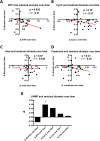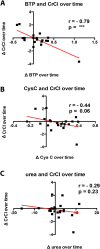Beta-trace protein as a potential biomarker of residual renal function in patients undergoing peritoneal dialysis
- PMID: 33706697
- PMCID: PMC7953776
- DOI: 10.1186/s12882-021-02287-0
Beta-trace protein as a potential biomarker of residual renal function in patients undergoing peritoneal dialysis
Abstract
Background: Residual renal function is closely linked to quality of life, morbidity and mortality in dialysis patients. Beta-trace protein (BTP), a low molecular weight protein, has been suggested as marker of residual renal function, in particular in patients on hemodialysis. We hypothesized that BTP also serves as a marker of residual renal function in pertioneal dialysis patients.
Methods: In this study 34 adult patients on peritoneal dialysis were included. BTP, creatinine, cystatin C and urea concentrations were analyzed simultaneously in serum and dialysate to calculate renal and peritoneal removal of the analytes.
Results: In peritoneal dialysis patients with residual diuresis, mean serum BTP was 8.16 mg/l (SD ± 4.75 mg/l). BTP correlated inversely with residual diuresis (rs = - 0.58, p < 0.001), residual creatinine clearance (ClCr) (rs = - 0.69, p < 0.001) and total urea clearance (Clurea) (rs = - 0.56, p < 0.001). Mean peritoneal removal of BTP was 3.36 L/week/1.73m2 (SD ± 1.38) and mean renal removal 15.14 L/week/1.73m2 (SD ± 12.65) demonstrating a significant renal contribution to the total removal. Finally, serum BTP inversely correlated with alterations in residual diuresis (r = - 0.41, p = 0.035) and renal creatinine clearance over time (r = - 0.79, p = p < 0.001).
Conclusion: BTP measurement in the serum may be a simple tool to assess residual renal function in peritoneal dialysis patients.
Keywords: Beta-trace protein; Low-molecular weight proteins; Peritoneal dialysis; Residual diuresis.
Conflict of interest statement
The authors declare that they have no competing interest that could be perceived as prejudicing the impartiality of the research reported.
Figures





References
-
- Bargman JM et al., Relative Contribution of Residual Renal Function and Peritoneal Clearance to Adequacy of Dialysis: A Reanalysis of the CANUSA Study. JASN 2001, 12 (10) 2158–2162. - PubMed
-
- Termorshuizen F, et al. Relative contribution of residual renal function and different measures of adequacy to survival in hemodialysis patients: an analysis of the Netherlands cooperative study on the adequacy of Dialysis (NECOSAD)-2. J Am Soc Nephrol. 2004;15(4):1061–1070. doi: 10.1097/01.ASN.0000117976.29592.93. - DOI - PubMed
Publication types
MeSH terms
Substances
LinkOut - more resources
Full Text Sources
Other Literature Sources
Medical

